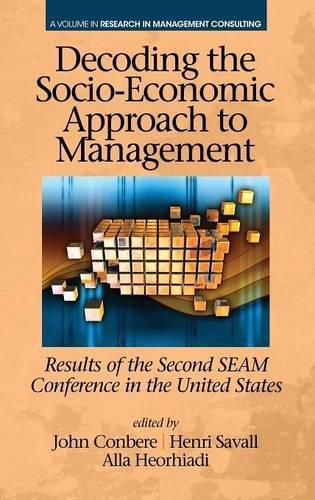Readings Newsletter
Become a Readings Member to make your shopping experience even easier.
Sign in or sign up for free!
You’re not far away from qualifying for FREE standard shipping within Australia
You’ve qualified for FREE standard shipping within Australia
The cart is loading…






This title is printed to order. This book may have been self-published. If so, we cannot guarantee the quality of the content. In the main most books will have gone through the editing process however some may not. We therefore suggest that you be aware of this before ordering this book. If in doubt check either the author or publisher’s details as we are unable to accept any returns unless they are faulty. Please contact us if you have any questions.
In May 2014, the French research laboratory ISEOR (Socio?Economic Institute for Firms and Organizations) and the University of St. Thomas co?sponsored a second conference on the application of the Socio?Economic Approach to Management (SEAM) paradigm and methodology in the United States. SEAM is a scientific approach to consultancy that focuses on uncovering the dysfunctions and hidden costs that exist in organizations, hidden in the sense that they are not captured by traditional accounting methodsand financial analyses. Through intervention that encompasses the entire organization - what the ISEOR team refers to as the HORIVERT approach (combining horizontal and vertical intervention) - the underlying goal is to enhance organizational performance by attacking the TFW virus, a vestige of the early work by Frederick Taylor, Henri Fayol, and Max Weber that has sufficiently infiltrated our thinking about management and organization to the point where are falling well short of our own potential. The resultant dysfunctions this virus unleashes creates hidden costs that readily destroy a firm’s value?added possibilities. The volume captures the ideas, applications, and exchanges of that meeting, attempting to bring the reader into the conference itself. Chapters include the contributors’ presentations ( Chapter Prologue: Conference Remarks ), revised conference papers, and the question and answer dialogue for the session.
$9.00 standard shipping within Australia
FREE standard shipping within Australia for orders over $100.00
Express & International shipping calculated at checkout
This title is printed to order. This book may have been self-published. If so, we cannot guarantee the quality of the content. In the main most books will have gone through the editing process however some may not. We therefore suggest that you be aware of this before ordering this book. If in doubt check either the author or publisher’s details as we are unable to accept any returns unless they are faulty. Please contact us if you have any questions.
In May 2014, the French research laboratory ISEOR (Socio?Economic Institute for Firms and Organizations) and the University of St. Thomas co?sponsored a second conference on the application of the Socio?Economic Approach to Management (SEAM) paradigm and methodology in the United States. SEAM is a scientific approach to consultancy that focuses on uncovering the dysfunctions and hidden costs that exist in organizations, hidden in the sense that they are not captured by traditional accounting methodsand financial analyses. Through intervention that encompasses the entire organization - what the ISEOR team refers to as the HORIVERT approach (combining horizontal and vertical intervention) - the underlying goal is to enhance organizational performance by attacking the TFW virus, a vestige of the early work by Frederick Taylor, Henri Fayol, and Max Weber that has sufficiently infiltrated our thinking about management and organization to the point where are falling well short of our own potential. The resultant dysfunctions this virus unleashes creates hidden costs that readily destroy a firm’s value?added possibilities. The volume captures the ideas, applications, and exchanges of that meeting, attempting to bring the reader into the conference itself. Chapters include the contributors’ presentations ( Chapter Prologue: Conference Remarks ), revised conference papers, and the question and answer dialogue for the session.